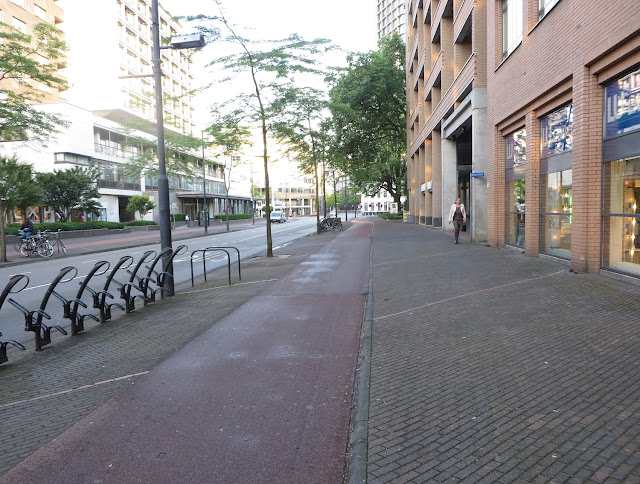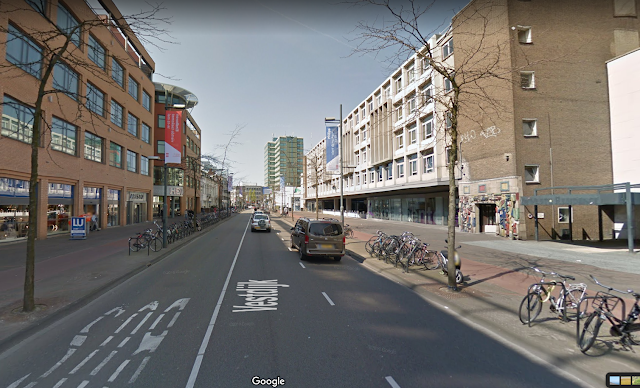Downham Road in the London borough of Hackney runs between the A10, close to Haggerston Overground station, through to the junction of Southgate Road at the Hackney / Islington borough border. It does also continue west into Islington, however, since 2020 has had a filter placed west of the Southgate Road junction as part of the Canonbury East Low Traffic Neighbourhood. However the section within Hackney is most certainly not a low traffic street with nearly 8,000 motor vehicles a day using it, making it a very unpleasant road to cycle on, one which I avoid and go out of my way not to use, wherever possible.
Somebody should do a series of videos called A Dutch Road Engineer Reacts to Videos of UK Road Design
— cul-de-sac-ney (@iambrianjones) April 30, 2022
pic.twitter.com/eqoB79NRJy
 |
| Local children campaigning to make Downham Road safer in the 1970s, it remains almost exactly the same now as it did then. Image taken by Neil Martinson. |
The only benefit of Downham Road being very wide is that this would allow for a considerable redesign of the road and there is very clearly ample space for protected cycle tracks, something I pointed out 7 years ago using a comparison with a road I had also cycled on before and after a redesign in Nijmegen, the Netherlands:Crash on Downham Road in Hackney with an overturned vehicle. This is such a terrible road, very wide so drivers often fly down here at high speed pic.twitter.com/XxO9DVMV0p
— Hackney Cyclist (@Hackneycyclist) December 4, 2019
Cycle tracks on Downham Road in De Beauvoir Town would be fantastic. Could look like these cycle tracks recently built in Nijmegen pic.twitter.com/8lHvF8NZ3D
— Hackney Cyclist (@Hackneycyclist) July 7, 2017
 |
| Google Streeview of the street in Nijmegen in 2016, before improvement works to this wide street began |
After two years and growing to 150 pupils it then moved into a temporary new space using portable cabins at the other end of Downham Road, opposite Ufton road, where it remained until it moved into its now permanent location on the site of the former fire station on the corner of the A10 and Downham Road. This does mean that some of the pupils who were the first to enter this new primary school fresh from Nursery back in 2015 are now teenagers, and unfortunately had to put up with 7 years of a school run along a hostile, busy road with many of them forced to cycle on the pavement every day throughout their primary school years, often alongside their parents.
Both the school and local parents pushed the council for changes to a safer road layout, the demands increasing as the number of pupils attending the school grew each year. In 2021 officers from the Hackney Council streets department had a walk around with parent representatives from the schools Air Quality and Road Safety Group. A list of not very impressive "improvements" were put forward including bike stop boxes at the traffic signals and pavement build outs. Council Highways officers also "discussed the difficulties with including separate cycle lanes" to which the parents obviously expressed their clear objections to the ridiculous suggestion that primary school children cycling to school should be expected to navigate new pinch points in primary position amongst thousands of cars and lorries when there is ample space for protected cycle lanes as part of a new layout.
 |
Downham Road outside Hackney New Primary School at afternoon pick up time. It would be preposterous to suggest primary school children are safe cycling among motor traffic here. |
Following these objections, despite repeatedly suggesting that introducing cycle lanes on Downham Road was "not suitable", without ever giving any reasoning for this, the council then announced they had designed two options; an unsafe option 1 with a narrowed carriageway and no safe space for children to cycle, and a safe option 2 which considered the needs of all road users and included footways, cycleways, a roadway and greenery / pedestrian crossing points.
I attended the drop in public engagement session on Downham Road in November 2022 where the unsafe and safe proposals were presented. Perhaps naively I was expecting this to be an actual fair and reasoned engagement and figured that surely everyone would agree that the correct conclusion was that option 1 was a ridiculous concept to even consider on a road with a primary school that carries 8,000 motor vehicles a day.
Below: Option 2 on display at the public engagement. Not a bad design, only negative would be the loading bay in the cycle track (easily solved by moving it around the corner into Hertford Road) and ideally swap the greenery so it is in between the cycle track and roadway but generally a decent design.
 |
Any preconceptions I had that this "public engagement" was a genuine exercise to explore and discuss the two options were dashed as soon as I walked through the door, where I was approached by Hackney Council middle aged man number one who showed me the "beautiful" option 1 on a large A1 piece of paper, where the greenery and planting was endlessly highlighted. He then proceeded to tell me that "some cyclists" want cycle lanes here and "we would have to remove all of the car parking for these people". He then stared at me, clearly desperately hoping I would be a local car driver ready to object in writing. When I informed him that it was utterly ridiculous to suggest that option 1 was safe for children to cycle to school he lost all interest in the conversation and turned away, approaching other new arrivals, clearly hoping they were local car drivers.
I examined the two proposals further and then became engaged in conversation with Hackney Council middle aged man number two and Hackney Council middle aged man number three who proceeded to "explain" to me the issues that cycle lanes cause for disabled people, both completely unaware of the great advantages cycle lanes can have for people with mobility issues.
One thing that is very noticeable in the Netherlands is the huge amount of elderly or people with mobility issues you see everywhere, all the time. The network of protected cycle tracks and low traffic neighbourhoods gives these people so much freedom pic.twitter.com/cmWC5mttNq
— Hackney Cyclist (@Hackneycyclist) June 25, 2023
The conversation then turned to pedestrians where middle aged man number two informed me that at the proposed informal crossings where "cyclists don't stop for pedestrians" pedestrians would "have to wait four times" to cross the road and proceeded to act out a ridiculous impression of someone crossing a four lane high speed motorway.
Below: Wick Road in Hackney where pedestrians do not have to wait four times to cross the road at this informal crossing, they simply wait until there is a gap in traffic in both directions, same as they would without the cycle lanes.
 |
As depressing and ill informed as these views were they were not surprising. Hackney Councils highways team have long been a band of middle aged men with a seriously unhealthy dislike of protected cycle tracks and absolutely no empathy for children or families cycling on their road network. Clearly this has been influenced from years of leading figures within the council such as former councillor Vincent Stops, who now spends his days obsessively campaigning against safe cycle infrastructure all day long on twitter, only getting attention for London cab drivers and anti LTN conspiracy theorists, along with former Hackney Council principal transport planner Roger Blake:
"Do more in London"? Given your record that should be quite enough to send shivers down the spines of everyone who values an inclusive accessible public realm, rather than your hallmark silo-centric exclusive segregationist dogma-driven zealotry worsening travel for the majority.
— Roger (@Roger89835988) October 11, 2022
Hackney Councils middle aged men have form for this kind of design, back in 2015 they proposed a redesign of Wick Road from a busy one way road to a busier two way road but without protected cycle tracks. In the consultation only 32% of local residents supported the designs with 68% of local residents voicing their opposition to the unsafe plans. Fast forward two years and an improved design with protected cycle tracks (with the loss of 110 car parking spaces to accommodate them) was presented. This gained 71% support and 26% disapproval from local residents and the scheme went ahead successfully.
 |
| Before and after on Wick Road. The original rejected consultation was to keep all the car parking and have no safe cycle tracks, exactly as is being proposed on Downham Road. |
Steer Group were commissioned to analyse the public engagement results and also the proposed design options from a technical point of view. They concluded that "option 1 would not be safe for children to cycle on the traffic lane, especially during peak hours as current traffic is greater than 6,000 pcus/day" (The London cycling campaign currently state that streets with motor traffic levels above 2,000 PCUs/day cycling should be physically separated from motor traffic to allow people of all ages and abilities to cycle). The Steer report states that "Option 2 (one-way 2m-wide segregated cycle lanes on either side of Downham Road) comfortably meets LTN1/20 standards for with-flow cycle tracks and would be suitable for ages 8-80".
A large part of the assessment was on the impact to motor traffic, with a Hackney Council "target" to retain car parking and the school pick up / drop off by car. The report concluded that "under Option 2, school pick-up/ drop-off from private motor vehicles won't be permitted along Downham Road. It is therefore expected that pick-up/ drop-off will be displaced to surrounding streets (i.e. Hertford Road, Enfield Road). On the other hand, the proposals will encourage active travel (walking, cycling and scooting) for getting to and from the school which should mitigate the adverse impact to the surrounding road network."
Primary school run, Eindhoven 2020 pic.twitter.com/HNYRWzobMe
— Hackney Cyclist (@Hackneycyclist) January 2, 2024
 |
On Whiston Road there now stands a white memorial bike.
— Kylie 🚲 (@netwench) November 20, 2023
This is where Gao Gao, 36, suffered critical injuries causing her death after being hit by a car driven by Martin Reilly.
A bike to remember Gao Gao & to remind @hackneycouncil that Whiston Rd must be filtered.@metecoban92 pic.twitter.com/7QPICZrDLh
This morning your cycle safety team have been at Whiston Road E2 carrying out a #closepass initiative due to concerns expressed by our followers.
— Cycle Safety Team (@MetCycleCops) May 1, 2018
3 close passes
Several other offences also dealt with pic.twitter.com/50Lpl7jdJh
A century of male dominated planning has resulted in streets shaped for one purpose: the commute to work.
— Melissa & Chris Bruntlett (@modacitylife) March 28, 2023
Only when cities start taking into account the many other “care trips” residents take in the day do they become more inclusive and gender equitable.https://t.co/Z0gn9MnEnu pic.twitter.com/rOJ0BKjpvN
 |
| The road as pictured in 2019, car parking on both sides of the road (the parking on the left is suspended as building work had just started on the school). Quite a similar layout to Downham Road. |
 |
| On the much narrowed roadway a brick surface has been used to ensure slower motor traffic |
Safe cycling for school children and parents at a recently upgraded street outside a new school in Amsterdam pic.twitter.com/EQgzoZbsF4
— Hackney Cyclist (@Hackneycyclist) January 12, 2024
Streets designed to encourage physical and social activity are a right all children should be able to enjoy; not just the Dutch.
— Dutch Cycling Embassy (@Cycling_Embassy) October 6, 2023
It requires prioritizing the safety of the most vulnerable; allowing them to experience the outside world on their own terms. pic.twitter.com/jIE0OkUgMU


























































